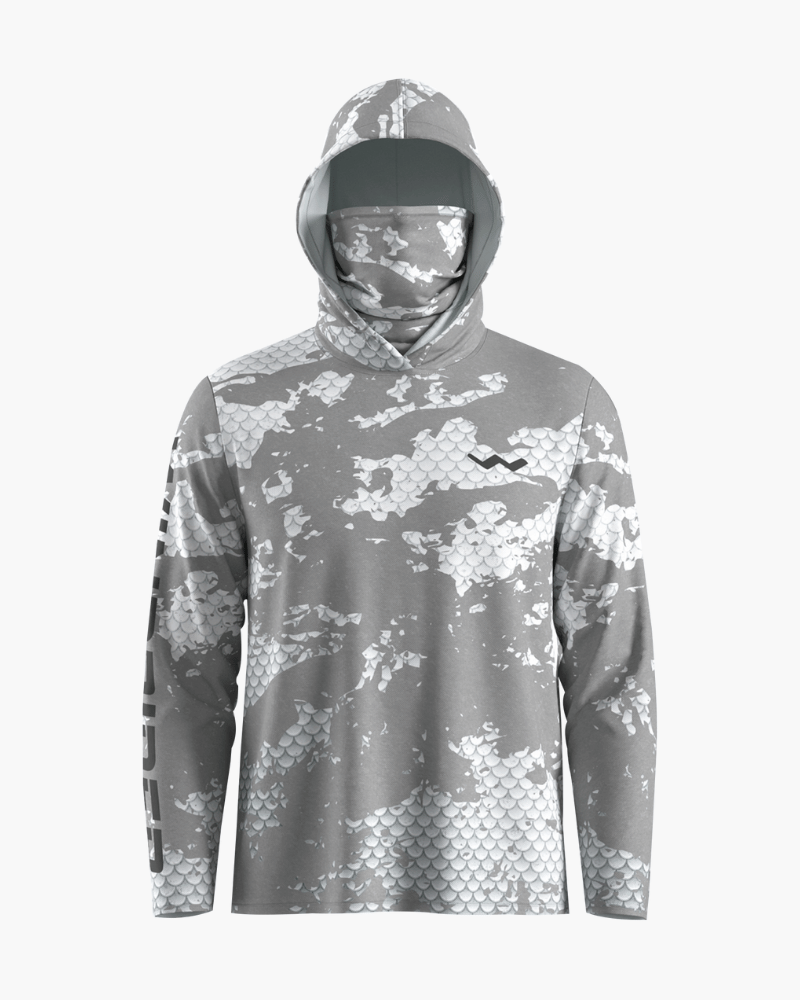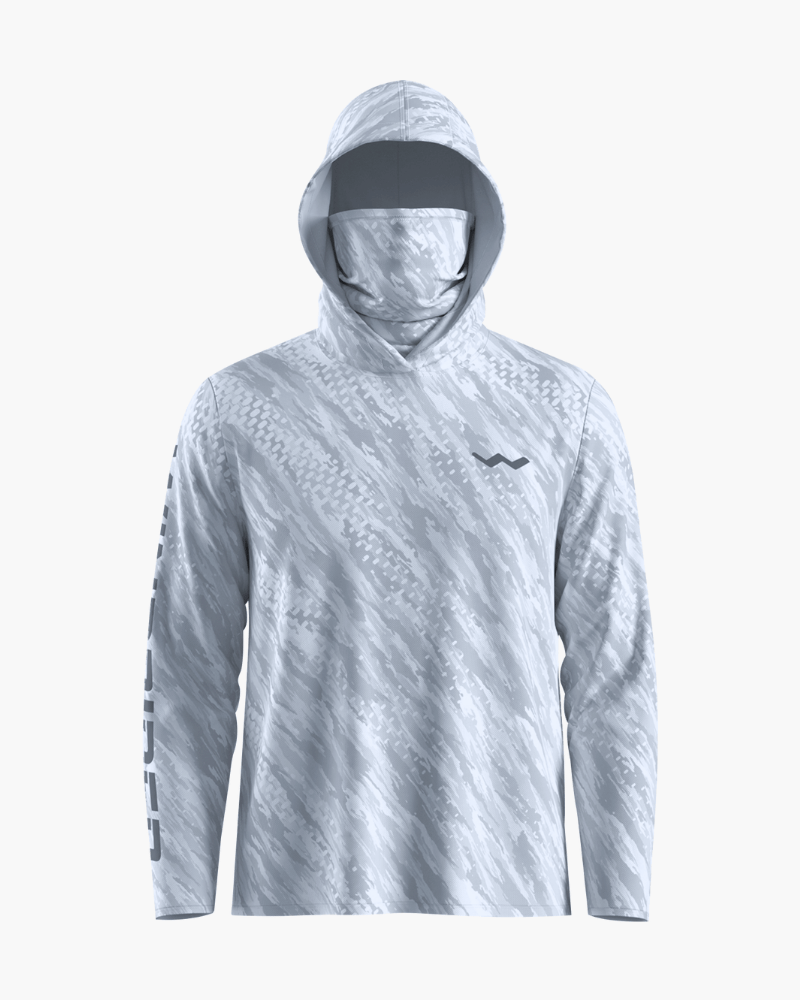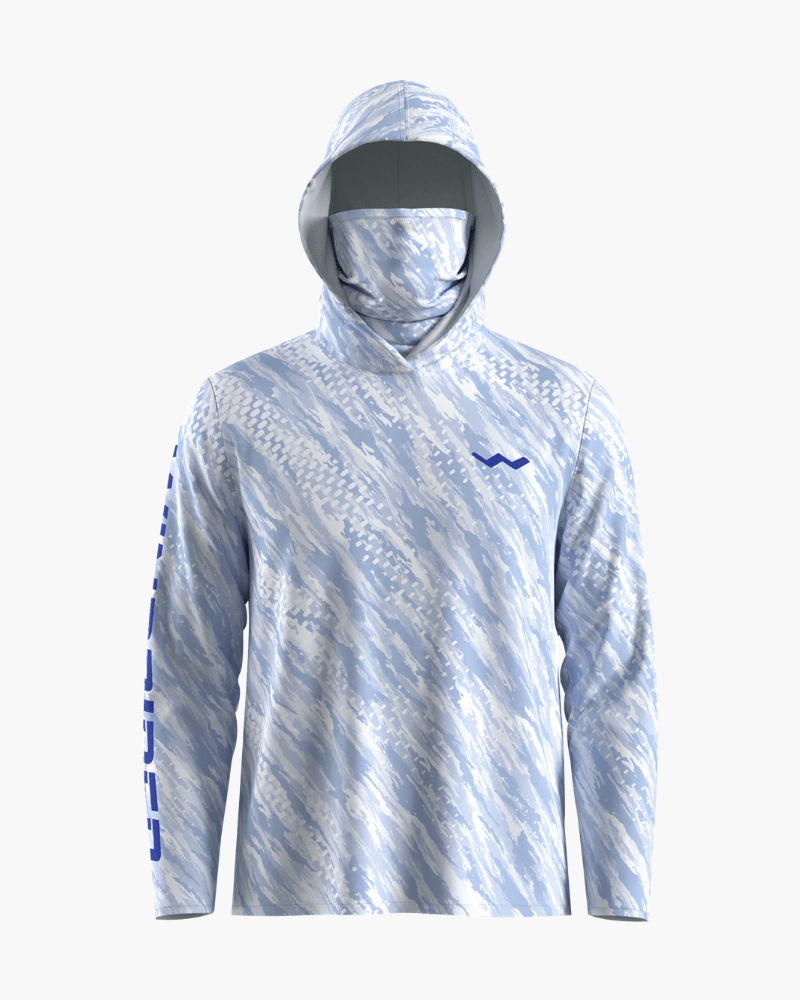The Coverage Gap: Why Traditional Sun Protection Falls Short
Walk down any marina on a sun-drenched afternoon and you'll see anglers wearing baseball caps, neck gaiters, and long-sleeve shirts—still walking away with sunburns. The culprit is gaps. A cap leaves ears exposed, neck gaiters slip down as the day progresses, and the thin strip of skin between shirt collar and gaiter becomes an open invitation for sun.
Dermatologists label these areas as "sun-exposure gaps"—regions where protection fails due to movement, poor fit, or forgetfulness. Ears are particularly vulnerable, absorbing some of the highest UV doses on the body while proving notoriously difficult to protect with sunscreen. Studies show that despite comprising under 2% of body surface area, ears are behind roughly 6-8% of all skin cancers.
The hooded fishing shirt design addresses this problem by delivering all-around coverage. When you pull the hood up and snap the gaiter into place, a continuous shield stretches from waist to the top of your head, leaving only your eyes exposed. No gaps, no missed patches, and no lingering worry about forgotten sunscreen spots.
The Surprising Advantage of Built-In Gaiters Over Buffs

Standalone buffs and neck gaiters work, but they bring a suite of irritating drawbacks. They habitually slip down as the day wears on, forcing readjustments. Sweat and salty spray soak them through, leaving a clammy feel against the face. They snag on sunglasses straps and hat brims. Perhaps most annoyingly, they add an extra piece of gear you must remember to pack, wash, and replace when it goes missing.
Built-in gaiters on the Helios are attached to the shirt at several anchor points, effectively preventing them from sliding down. Because they're cut from the same moisture-wicking, quick-dry fabric as the rest of the shirt, they maintain a consistent level of comfort across your entire upper body.
When you need to sip water, take a lunch break, or communicate clearly, integrated gaiters tuck away in seconds. You slide the gaiter down over your neck, attend to the task, then raise it again. Using a buff forces you into a perpetual dance with a piece of fabric that's always on the verge of slipping off or disappearing.
The Atoll Hooded Shirt advances this concept further, fitting a gaiter that drapes over nose and mouth while staying breathable during vigorous activity. Its fabric permits respiration yet filters out harmful UV rays—a balance that thick standalone buffs often struggle to achieve.
Hooded vs Standard Fishing Shirts: A Direct Comparison

Choosing between a hooded fishing shirt and a regular one hinges on your specific angling style, sun sensitivity, and comfort preferences. Neither style can claim absolute superiority—each simply meets different needs.
Standard Long-Sleeve Shirts
Standard long-sleeve shirts like the base Helios Long Sleeve Sun Shirt excel when airflow is paramount. When fishing under scorching conditions—95°F+ with high humidity—the open-neck style lets air circulate and heat dissipate. Anglers who already favor a hat setup or who find hoods suffocating tend to gravitate toward these straightforward designs.
Standard shirts typically excel when you need:
- Maximum airflow in sweltering, humid heat
- Anglers who habitually fish at daybreak or nightfall when sun hangs low and intensity is reduced
- Scenarios where you're frequently removing and re-donning the shirt
- Fishermen who favor the feel and fit of classic collared designs
Hooded Fishing Shirts with Gaiters
Hooded fishing shirts with gaiters become essential when the sun hangs overhead for hours on end. For 10-12 hour tropical fishing marathons, all-around protection more than compensates for the slight loss in breathability. The hood wraps around ears, covers the nape of your neck, and tops your head—spots that otherwise absorb UV rays while you're casting line after line.
Hooded shirts truly shine for:
- Full-day offshore adventures where shade is scarce if it appears at all
- Flats fishing where the sun's reflected glare dramatically increases UV exposure
- Anglers with fair complexion or past skin cancer diagnoses
- Prime fishing locales near the equator where sun hangs directly overhead
- Scenarios where you want to minimize sunscreen usage
Real-World Performance: Twelve Hours on the Water
According to numerous anglers, hooded fishing shirts truly excel during the sun's peak hours—roughly 10 AM to 4 PM. Once the day transitions toward dawn or dusk when sun hangs low on the horizon, the hood's importance wanes, prompting anglers to stow it away.
The gaiter excels in sweaty face-covering moments—when poling a skiff, fighting a fish, or cutting through rough water. Its integrated one-piece construction stays put while you work, unlike buffs that shift and slide as soon as they get wet.
Managing Heat in Hooded Designs
People often wonder if a hooded fishing shirt will cause overheating. While covering your entire head might seem like a surefire way to get hotter, whether that happens hinges on fabric technology and specific design details.
Hooded fishing shirts are fashioned from a single breathable moisture-wicking fabric that encompasses the entire garment. The hood, weighing no more than a few ounces, mirrors the shirt's rapid evaporative performance. Upon contact with sweat, the hood's textile diffuses the liquid and vaporizes it swiftly, yielding a cooling effect instead of a heat-trapping one.
The decisive factor is fabric weight. The Hooded Helios is cut from a 3.5-4 oz textile that provides body to hold its shape while remaining virtually weightless. Budget hooded shirts built with 6-8 oz material tend to trap warmth, making them feel oppressive on hot days.
Mesh ventilation panels, common on baseball caps, are generally excluded from hooded fishing shirts. The omission is deliberate—mesh would allow UV rays to slip through, nullifying the hood's purpose. Instead, the entire hood is crafted from air-permeable fabric that blocks UV while still allowing airflow.
Face Gaiter Breathability and Comfort
Drawing breath through fabric while fishing isn't a minor nuisance—it's a genuine concern. When a gaiter throttles airflow, you'll start gasping and feel uncomfortable within minutes.
The Hooded Helios and Atoll shirts sport gaiters fashioned from open-weave technical fabric that lets air flow freely even during moderate effort. You can pole a skiff, wander along the beach, or tend to lures without feeling like oxygen's been squeezed out. The material acts as a breathable barrier rather than a restrictive mask.
However, when you're really pushing yourself—covering distance on foot or sprinting—you may want to pull the gaiter down temporarily. For standard fishing tasks, whether battling a fish or handling bait, the gaiter remains comfortable and unobtrusive.
Browse our rain gear collection for more options.
Some anglers initially experience a claustrophobic sensation when wearing face coverage. Typically this feeling dissipates after 15-20 minutes as you acclimate. Should the claustrophobia linger, you can opt to wear just the hood—leaving the gaiter down—or revert to a conventional shirt style.
Sunscreen's Hidden Savings: An Overlooked Benefit
A decent bottle of sunscreen—$12 to $18—gets burned through quickly by avid anglers who typically go through one every 2-3 weeks, ballooning the annual sun protection bill to somewhere between $200 and $300. Add a fishing shirt and the story changes: the garment covers about 60-70% of the skin that would otherwise need sunscreen, slashing consumption dramatically.
Thanks to the protection of a hooded gaiter shirt, the only spots requiring sunscreen are:
- Hands and backs of fingers
- A small exposed region around the eyes
- Any part of the chest exposed when fishing with gaiter down
- Legs (if wearing shorts)
Cutting the amount of sunscreen needed reduces usage by more than half. Over a fishing season, the hooded shirt essentially pays for itself through sunscreen savings while delivering protection that even the best sunscreen can't match.
Furthermore, eliminating sunscreen on face and neck removes that greasy film that would otherwise coat fingertips while handling line, tying knots, or managing fish. Any sunscreen that clings to fingers can migrate onto fishing line, undermining knot strength and causing line to slip precisely when it matters most.
When Hoods and Gaiters Prove Indispensable
In some fishing situations, a hooded gaiter shirt is essentially mandatory:
Tropical fishing destinations: When anglers venture into the Caribbean, Central America, or other equatorial waters, the sun's intensity can overwhelm traditional protection. At latitudes around 20°N or lower, midday UV regularly climbs into the 11+ range on the UV Index.
Multi-day fishing trips: On marathon outings where line is cast from sunrise to sundown day after day, the sun's cumulative effect can become hazardous. A hooded shirt emerges as reliable protection, maintaining defense across 40-60 hours of nonstop angling.
Offshore trolling and kite fishing: You'll often end up exposed in full unfiltered sun with no shade for 6-10 hours. The brutal overhead glare, doubled by water's mirror-like reflection, makes top-level protection an absolute must.
Summer flats fishing: Light-colored sand reflects 20-25% of UV radiation upward so rays strike the face from below while sun above still beams down. With UV hitting from both directions, face protection becomes essential.
Integrated Hood Systems vs Separate Hat Alternatives
Traditional fishing hats fall short. A baseball cap will keep glare off the front of your face when sun's ahead but does nothing for the exposed neck. A wide-brimmed hat spreads shade farther but tends to act like a kite in breeze, throws off casting rhythm, and becomes a clumsy weight when hauling in a big fish.
The hood system on performance fishing shirts envelops your entire head, offering unwavering shade regardless of sun's angle. Its fabric follows your motion during a cast, refuses to catch wind or peel away, and banishes the dreaded sweaty hat-hair that classic caps often cause.
For anglers who're adamant about wearing a hat—whether it's a fashion statement or a practical platform for mounting electronics or lights—the hood can be tucked beneath it, acting as backup protection. Because the fabric is lightweight, it stays unobtrusive and doesn't add uncomfortable bulk under most fishing caps.
Care and Upkeep to Maintain Performance Over Time
Hooded fishing shirts need the straightforward care that applies to any technical top. After use in saltwater, a rinse under fresh water washes away salty crystals that would otherwise chip away at fibers over time. Afterwards, a cold-water machine wash with mild detergent does the trick, and skipping fabric softener keeps wicking ability unblocked.
Air drying—by sparing the fabric from rigors of the dryer—prolongs the lifespan of shirts. They are sturdy enough to endure a low-heat tumble without damage. Their quick-dry nature means the pieces are back in wear-ready condition after 2-3 hours of washing, even when no mechanical drying is employed.
By integrating the gaiter, the specter of misplacing a buff—whether it slips overboard or gets abandoned in the truck—vanishes. The entire assembly stays fastened, streamlining gear logistics and guaranteeing that the protection you rely on is always within reach when needed.

